Learn about projects and solutions using Visual Basic
In this introductory article, we'll explore what it means to create a solution and a project in Visual Studio. A solution is a container that's used to organize one or more related code projects, for example a class library project and a corresponding test project. We'll look at the properties of a project and some of the files it can contain. We'll also create a reference from one project to another.
If you haven't already installed Visual Studio, go to the Visual Studio downloads page to install it for free.
We'll construct a solution and project from scratch as an educational exercise to understand the concept of a project. In your general use of Visual Studio, you'll likely use some of the various project templates that Visual Studio offers when you create a new project.
Solutions and projects aren't required to develop apps in Visual Studio. You can also just open a folder that contains code and start coding, building, and debugging. For example, if you clone a GitHub repo, it might not contain Visual Studio projects and solutions. For more information, see Develop code in Visual Studio without projects or solutions.
Solutions and projects
Despite its name, a solution is not an "answer". A solution is simply a container used by Visual Studio to organize one or more related projects. When you open a solution in Visual Studio, it automatically loads all the projects that the solution contains.
Create a solution
We'll start our exploration by creating an empty solution. After you get to know Visual Studio, you probably won't find yourself creating empty solutions often. When you create a new project, Visual Studio automatically creates a solution to house the project if there's not a solution already open.
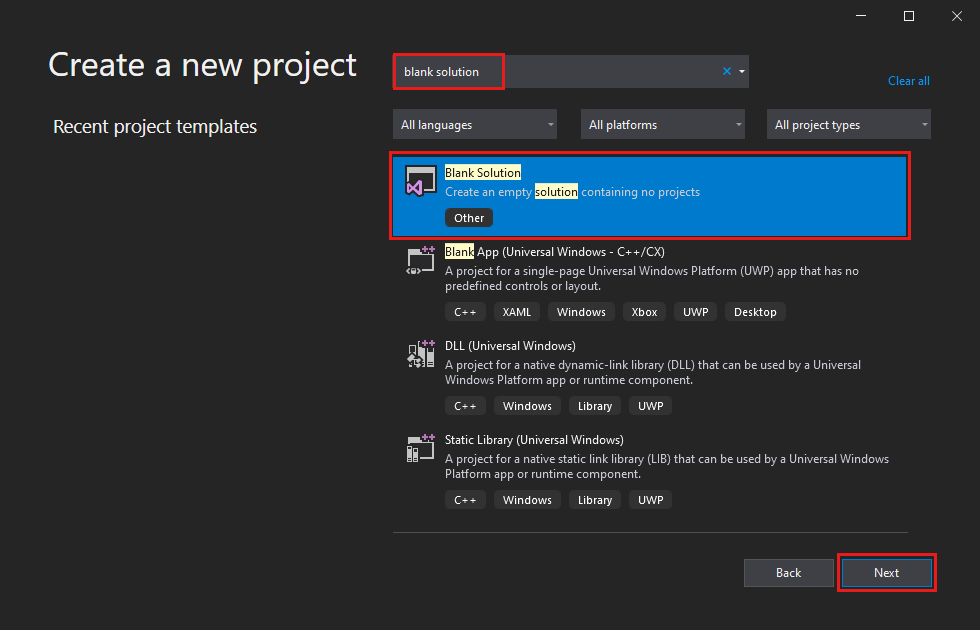 Create a new project window with " />
Create a new project window with " />
- Open Visual Studio.
- On the start window, choose Create a new project.
- On the Create a new project page, enter blank solution into the search box, select the Blank Solution template, and then choose Next.
- Name the solution QuickSolution, and then choose Create. A solution appears in Solution Explorer on the right-hand side of the Visual Studio window. You'll probably use Solution Explorer often, to browse the contents of your projects.
 Create a new project window with " />
Create a new project window with " />
- Open Visual Studio.
- On the start window, choose Create a new project.
- On the Create a new project page, enter blank solution into the search box, select the Blank Solution template, and then choose Next.
- Name the solution QuickSolution, and then choose Create. A solution appears in Solution Explorer on the right-hand side of the Visual Studio window. You'll probably use Solution Explorer often, to browse the contents of your projects.
Add a project
Now let's add our first project to the solution. We'll start with an empty project and add the items we need to the project.
- From the right-click or context menu of Solution 'QuickSolution' in Solution Explorer, choose Add >New Project. A dialog box opens that says Add a new project.
- Enter the text empty into the search box at the top, and then select Visual Basic under Language.
- Select the Empty Project (.NET Framework) template, and then choose Next.
- Name the project QuickDate, then choose Create. A project named QuickDate appears beneath the solution in Solution Explorer. Currently it contains a single file called App.config.
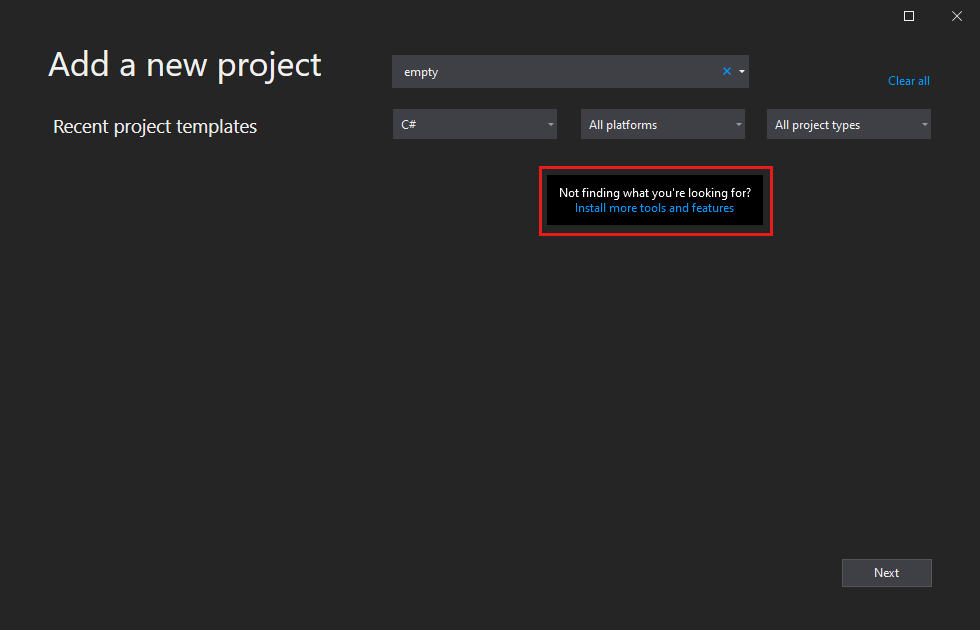 Create a new project window with the " />
Create a new project window with the " />
Note If you don't see the Empty Project (.NET Framework) template, you need to install the .NET desktop development Visual Studio workload. Visual Studio uses workload-based installation to only install the components you need for the type of development you do. An easy way to install a new workload when you're creating a new project is to choose the Install more tools and features link under the text that says Not finding what you're looking for?. After Visual Studio Installer launches, choose the .NET desktop development workload and then the Modify button.
- From the right-click or context menu of Solution 'QuickSolution' in Solution Explorer, choose Add >New Project. A dialog box opens that says Add a new project.
- Enter the text empty into the search box at the top, and then select Visual Basic in the All languages drop-down list.
- Select the Empty Project (.NET Framework) template, and then choose Next.
- Name the project QuickDate, then choose Create. A project named QuickDate appears beneath the solution in Solution Explorer. Currently it contains a single file called App.config.
 Create a new project window with the " />
Create a new project window with the " />
Note If you don't see the Empty Project (.NET Framework) template, you need to install the .NET desktop development Visual Studio workload. Visual Studio uses workload-based installation to only install the components you need for the type of development you do. An easy way to install a new workload when you're creating a new project is to choose the Install more tools and features link under the text that says Not finding what you're looking for?. After Visual Studio Installer launches, choose the .NET desktop development workload and then the Modify button.
Add an item to the project
We have an empty project. Let's add a code file.
- From the right-click or context menu of the QuickDate project in Solution Explorer, choose Add >New Item. The Add New Item dialog box opens.
- Expand Common Items, then choose Code. In the middle pane, choose the Class item template. Name the class Calendar, and then choose the Add button. A file named Calendar.vb is added to the project. The .vb on the end is the file extension that's given to Visual Basic code files. The file appears in the visual project hierarchy in Solution Explorer, and its contents open in the editor.
- Replace the contents of the Calendar.vb file with the following code:
Class Calendar Public Shared Function GetCurrentDate() As Date Return DateTime.Now.Date End Function End Class
Add a second project
It's common for solutions to contain more than one project, and often these projects reference each other. Some projects in a solution might be class libraries, some executable applications, and some might be unit test projects or websites.
Let's add a unit test project to our solution. This time we'll start from a project template so we don't have to add an additional code file to the project.
- From the right-click or context menu of Solution 'QuickSolution' in Solution Explorer, choose Add >New Project.
- In the Add a new project dialog box, enter the text unit test into the search box at the top, and then select Visual Basic under Language.
- Choose the Unit Test Project (.NET Framework) project template, and then choose Next.
- Name the project QuickTest, and then choose Create. A second project is added to Solution Explorer, and a file named UnitTest1.vb opens in the editor.
- In the Add a new project dialog box, enter the text unit test into the search box at the top, and then select Visual Basic in the All languages drop-down list.
- Choose the Unit Test Project (.NET Framework) project template, and then choose Next.
- Name the project QuickTest, and then choose Create. A second project is added to Solution Explorer, and a file named UnitTest1.vb opens in the editor.
Add a project reference
We're going to use the new unit test project to test our method in the QuickDate project, so we need to add a reference to that project. The reference creates a build dependency between the two projects, meaning that when you build the solution, QuickDate is built before QuickTest.
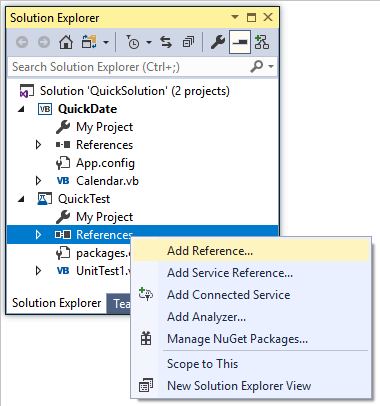
- Choose the References node in the QuickTest project, and from the right-click or context menu, choose Add Reference. The Reference Manager dialog box opens.
- In the left pane, expand Projects and choose Solution. In the middle pane, choose the checkbox next to QuickDate, and then choose the OK button. A reference to the QuickDate project is added.

- Choose the References node in the QuickTest project, and from the right-click or context menu, choose Add Reference. The Reference Manager dialog box opens.
- In the left pane, expand Projects and choose Solution. In the middle pane, choose the checkbox next to QuickDate, and then choose the OK button. A reference to the QuickDate project is added.
Add test code
- Now we'll add test code to the Visual Basic code file. Replace the contents of UnitTest1.vb with the following code.
Public Class UnitTest1 Public Sub TestGetCurrentDate() Assert.AreEqual(Date.Now.Date, QuickDate.Calendar.GetCurrentDate()) End Sub End Class
Imports System.Runtime.CompilerServices
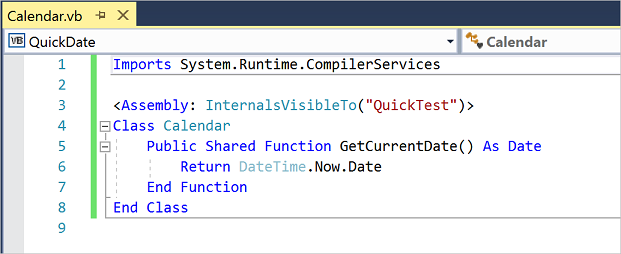
The code file should look like this:
- Now we'll add test code to the Visual Basic code file. Replace the contents of UnitTest1.vb with the following code.
Public Class UnitTest1 Public Sub TestGetCurrentDate() Assert.AreEqual(Date.Now.Date, QuickDate.Calendar.GetCurrentDate()) End Sub End Class
Imports System.Runtime.CompilerServices

The code file should look like this:
Project properties
The line in the Calendar.vb file that contains the InternalsVisibleToAttribute attribute references the assembly name (file name) of the QuickTest project. The assembly name might not always be the same as the project name. To find the assembly name of a project, open the project properties.
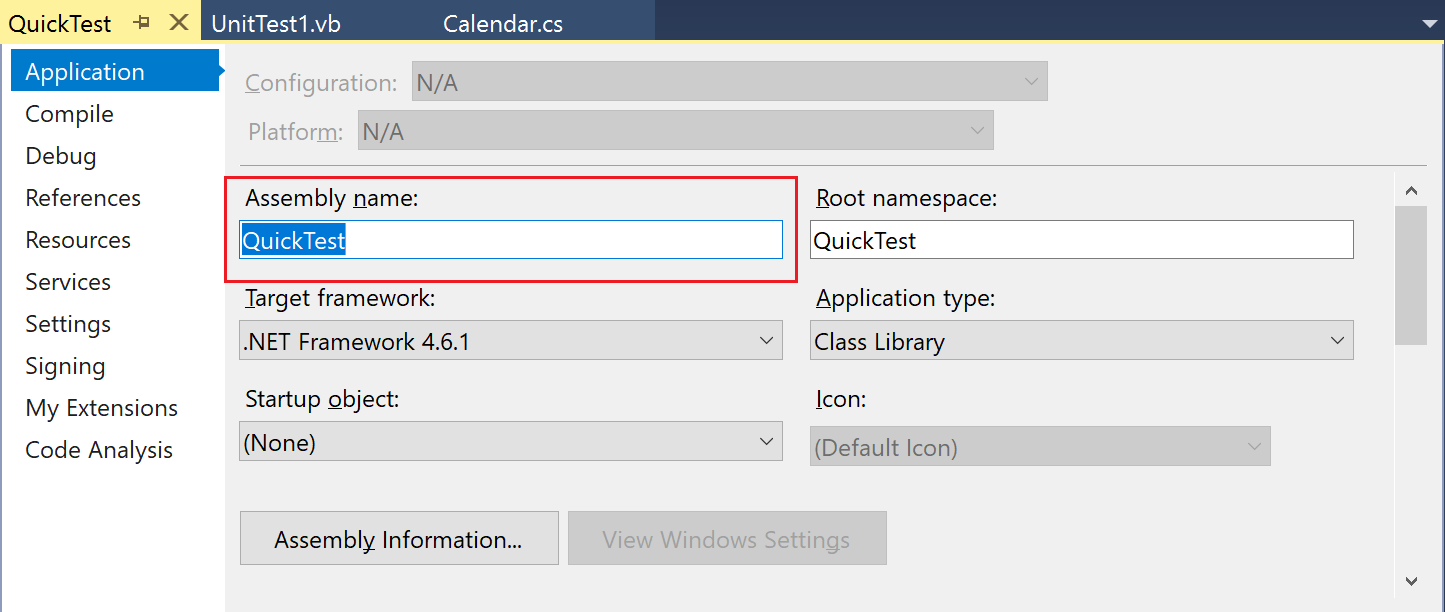
- In Solution Explorer, select the QuickTest project. From the right-click or context menu, select Properties, or just press Alt+Enter. (You can also double-click My Project in Solution Explorer.) The property pages for the project open on the Application tab. The property pages contain various settings for the project. Notice that the assembly name of the QuickTest project is indeed "QuickTest". If you wanted to change the assembly name, this is where you'd do that. Then, when you build the test project, the name of the resulting binary file would change from QuickTest.dll to whatever you chose.
- Explore some of the other tabs of the project's property pages, such as Compile and Settings. These tabs are different for different types of projects.
The line in the Calendar.vb file that contains the InternalsVisibleToAttribute attribute, references the assembly name (file name) of the QuickTest project. The assembly name might not always be the same as the project name. To find the assembly name of a project, open the project properties.

- In Solution Explorer, select the QuickTest project. From the right-click or context menu, select Properties, or just press Alt+Enter. (You can also double-click My Project in Solution Explorer.) The property pages for the project open on the Application tab. The property pages contain various settings for the project. Notice that the assembly name of the QuickTest project is indeed "QuickTest". If you wanted to change the assembly name, this is where you'd do that. Then, when you build the test project, the name of the resulting binary file would change from QuickTest.dll to whatever you chose.
- Explore some of the other tabs of the project's property pages, such as Compile and Settings. These tabs are different for different types of projects.
(Optional) Run the test
If you want to check that your unit test is working, choose Test > Run > All Tests from the menu bar. A window called Test Explorer opens, and you should see that the TestGetCurrentDate test passes.

If Test Explorer doesn't open automatically, open it by choosing Test > Windows > Test Explorer from the menu bar.
If you want to check that your unit test is working, choose Test > Run All Tests from the menu bar. A window called Test Explorer opens, and you should see that the TestGetCurrentDate test passes.

If Test Explorer doesn't open automatically, open it by choosing Test > Windows > Test Explorer from the menu bar.
Next steps
If you want to further explore Visual Studio, consider creating an app by following one of the Visual Basic tutorials.
See also
- Create projects and solutions
- Manage project and solution properties
- Manage references in a project
- Develop code in Visual Studio without projects or solutions
- Visual Studio IDE overview

 Create a new project window with " />
Create a new project window with " /> Create a new project window with " />
Create a new project window with " /> Create a new project window with " />
Create a new project window with " /> Create a new project window with the " />
Create a new project window with the " /> Create a new project window with the " />
Create a new project window with the " />






